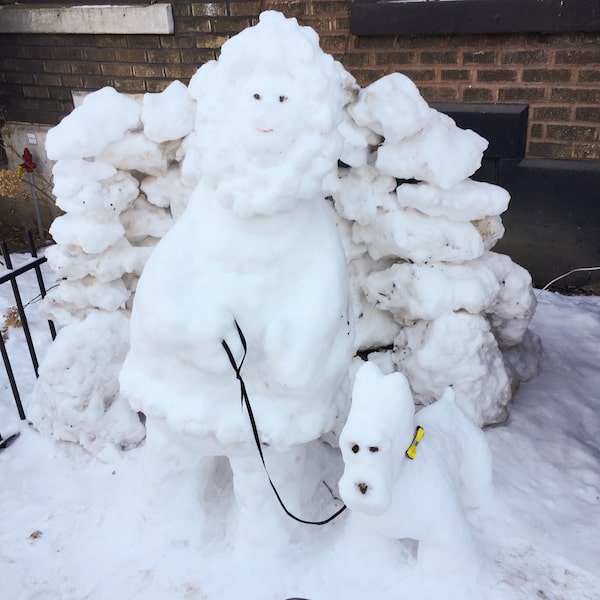
Karen Hayes recently built a snow sculpture of a woman walking her dog on her lawn in her Montreal.Handout
Karen Hayes, a 46-year-old hairdresser in Montreal, knocked on her neighbours door a few days ago and asked a question she hadn’t asked anyone since she was a kid.
“Do you want to come play in the snow with me?”
Hours later they had created a snowwoman walking a snow dog (a tribute to Ms. Hayes’s schnauzer, Molly, who died last year) and a family of snow bears.
Snow sculpting is the latest pandemic pastime. Like so many of the other ways of filling the days that became popular over the past year, whether it’s baking bread or going on hikes, it is a back-to-basics activity. Do you want to build a snowman? Bored and fed up with being stuck indoors, people are screaming yes they do, and happily venturing outside to let their imaginations run wild.
Some cities, including Toronto and Calgary, have seen more snow this winter than average, while others, such as Montreal, have had less of the white stuff than usual, according to Environment Canada. But whenever it comes and however much there is, people are eager to play with it.
Ahead of a snowstorm a few weeks ago, the City of Calgary sent out a tweet asking residents to create snow sculptures in their yards to “create Canada’s greatest snow sculpture display!” Afterward, examples that appeared on Twitter using the hashtag #SnowMuchFunYYC included a pair of dragons and forts decked out with pillows and lights. In Montreal, more than 2,000 people have already registered for a first of its kind snowman contest run by the city.
It’s no surprise as to why some people are going next level with their snow creations, according to Brandon McFarlane, a professor of creativity and creative thinking at Sheridan College, West of Toronto.
“There’s a huge connection between openness to experience and creativity,” he said.
With so many of our usual experiences denied to us, many of us are eager to find something to do. The other critical factor is that we’re bored.
“When you’re bored you’re really just looking for something to do or new goals to work on, and this sparks curiosity and encourages people to maybe try something new,” Dr. McFarlane said.
Mary Naciuk hadn’t made a snow sculpture in more than 20 years. It’s a skill she picked up when she was a hospital cook in Williams Lake, B.C., long before she became a physician. But on a rare day off earlier this month, Dr. Naciuk used a butter knife and a blowtorch to carve a dragon approximately five feet high and 10 feet long from a pile of snow on her front yard in Ottawa.
“There isn’t a whole lot to do when you do have a day off,” she said. “I needed some exercise and some fresh air and a creative outlet.”
An anonymous artist has been creating snow sculptures in Edmonton for the public to enjoy. So far the creations include a bear climbing a tree, an owl on a walking path and a polar bear waving at traffic.
That sense of community is part of what made a Saturday afternoon earlier this month so magical, said Montreal-based novelist Heather O’Neill.
As she walked to her studio from her apartment, she cut through a park and saw people building snowy creations of all types and sizes.
“I’ve never seen anything like it,” Ms. O’Neil said. “There was hundreds of snowmen everywhere. It was like they had sprung up like some city out of the ground.”
Some people making snowmen in the Montreal knew about the contest run by the city. Others, such as Ms. Hayes, did not. She was simply doing it for fun – but she enjoyed how much it brightened her neighbours’ moods.
“When you go outside and give a smile to someone it makes you smile, too,” she said.
How to build a snowman
Making a snow sculpture isn’t as difficult as some people might think, said Ritchie Velthuis, a former “chairperson of ice and snow” for the Sculptors’ Association of Alberta. Mr. Velthuis, an Edmonton-based sculptor, offers this guide for greatness.
Step 1
Draw your creation, preferably on graph paper, which will give you a good sense of scale, as well as provide a guide as to what elements go where. Once that’s done, just follow along.
Step 2
Take a cardboard box that is big enough to make an 18-inch square (at least). Remove the bottom. Fill the box with one foot of snow and then pack the snow in the box down as much as possible. If you fill it right to the top, when you stomp it down the bottom won’t be as compressed as the top will be. Keep making boxes of snow, filling in any spaces between the blocks by hand as you go, until you have a form big enough for whatever you plan on carving.
Step 3
Gather your tools: saws, ice chippers (the kind you use to chip ice off of a sidewalk), trowels and palette knives are all good. You can even use a steak knife with a pointy end to carve finer details.
Step 4
Leave the completed snow block for a day if you can to allow it to settle. But it’s okay to start carving right away. Don’t get caught up on details at the beginning. Get the form right: You want to make sure you have the general shape. Then you can start working on smaller bits.
Our Morning Update and Evening Update newsletters are written by Globe editors, giving you a concise summary of the day’s most important headlines. Sign up today.
 Dave McGinn
Dave McGinn